 |
 |
Arcade Faithful |
Recently, two of these holes have been plugged by the fantastic work of Bryan Edewaard and Ken Siders. Bryan wrote a perfect conversion of Warlords dubbed Castle Crisis and and Ken wrote an equally perfect conversion of Burgertime dubbed Beef Drop. These two games, written by an individual in his spare time, makes you wonder if the corporations of Atari and Mattel were sitting on their hands back in the heyday of video games.
I asked questions of Bryan and Ken and decided it'd be interesting to read about both of these great programming projects together in one interview.
Tell us about yourself. What do you do for a living?
Bryan (CC): I've been an Atari fan since I got my first 800 back in 1981. I used my computer all the time and kept up with the computer magazines, but I didn't learn to program as well as I wanted to. Much later on, when I'd become pretty good at PC programming, I went back and started experimenting with the Atari 8-bits again.
I've worked in music stores, Radio Shack, as a programmer, digital engineer, game designer, and technician. I even worked briefly with Atari Corp. Recently I've been doing freelance stuff, but I'm looking to get back to something more regular.
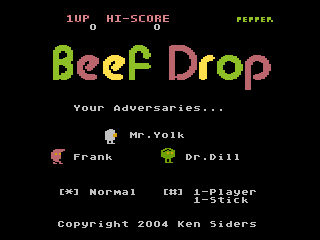 Ken
(BD): During the day at work I do computer programming, primarily in C,
mostly on Compaq/HP Alphas running VMS. I first got an atari 400 sometime in the
80's and eventually got an 800XL a couple years later. Programmed in Atari
Basic, and worked my way up to using some ML. I would say the first real game I
done was a couple Frogger clones in BASIC (long lost), and the first game
I did in ML was a pacman clone (long lost) but later I did a Pac-Man Jr
game which can be found on this page http://atari.ksiders.tzo.com/a8games.html. I also have did a game or two in
Action including an earlier Burgertime clone attempt.
Ken
(BD): During the day at work I do computer programming, primarily in C,
mostly on Compaq/HP Alphas running VMS. I first got an atari 400 sometime in the
80's and eventually got an 800XL a couple years later. Programmed in Atari
Basic, and worked my way up to using some ML. I would say the first real game I
done was a couple Frogger clones in BASIC (long lost), and the first game
I did in ML was a pacman clone (long lost) but later I did a Pac-Man Jr
game which can be found on this page http://atari.ksiders.tzo.com/a8games.html. I also have did a game or two in
Action including an earlier Burgertime clone attempt.
What is your favorite Atari system and why?
Bryan (CC): Although I have a special place in my heart for my original 800, my all-time favorite Atari machine is the 800XL. It represented the point where Atari finally delivered all the features in a low-cost package.
Ken (BD): Probably the 8-bit computers since I am most familiar with them and have used them the most.
What inspired you to write a clone of a classic arcade game?
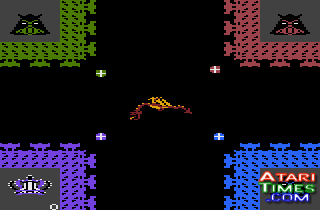 Bryan
(CC): In the early '90s I started collecting arcade video games. They
weren't worth much back then, and if you were handy with a soldering iron you
could literally fill a room with classics for a few hundred dollars. One of my
machines was a Warlords upright that I'd picked up for $50 or so. Since
the upright only has controllers for two players, I wired up an extra set of
paddles and it became the most popular game in my collection. I decided porting
it to the Atari would be a great exercise, and give me a much needed portable
version to boot. Unfortunately, it was many years before I took the time to make
anything that was actually playable.
Bryan
(CC): In the early '90s I started collecting arcade video games. They
weren't worth much back then, and if you were handy with a soldering iron you
could literally fill a room with classics for a few hundred dollars. One of my
machines was a Warlords upright that I'd picked up for $50 or so. Since
the upright only has controllers for two players, I wired up an extra set of
paddles and it became the most popular game in my collection. I decided porting
it to the Atari would be a great exercise, and give me a much needed portable
version to boot. Unfortunately, it was many years before I took the time to make
anything that was actually playable.
Ken (BD): (Burgertime) was one a few games that that seemed to exist for every system except the Atari 5200 and 8-bit computers. It is a game I thought to be well within the system's capabilities to get a relative accurate translation.
How did you get your game to look so much like the original?
Bryan (CC): I wrote several different programs to determine how much detail I could have and still have a manageable program. I did many things the hard way. I rewrote core parts of the program over and over to speed things up. I converted all the graphics by hand to get them as close to the original as possible while adjusting for the differences in resolution. I kept the original open in MAME all the time for inspiration.
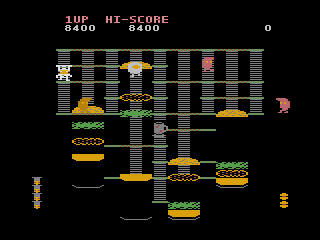 Ken
(BD): I spent a lot of time in MAME playing the game for a while to try and
learn when the pepper bonus objects appear, how certain events are scored, what
each level looks like.
Ken
(BD): I spent a lot of time in MAME playing the game for a while to try and
learn when the pepper bonus objects appear, how certain events are scored, what
each level looks like.
How long was the game in development?
Bryan (CC): If you start from my original test projects, about 7 years. I probably devoted about 2 years seriously to it.
Ken (BD): Before the original April fools release, I probably only had spent a few weeks on it. But...I had done lots of experiments for a couple months before that trying out some ideas.
Did you have to make any technical considerations when writing the game? How about converting it from 8-bit to 5200?
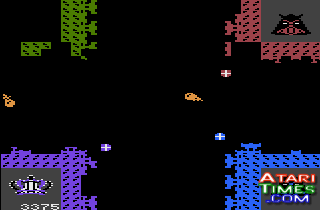 Bryan
(CC): One of the challenges when converting arcade graphics to the Atari
8-bits is dealing with the different aspect ratio. Arcade hardware usually draws
square pixels, and screen is laid out as a grid of neat 8x8 squares. On the
Atari, pixels aren't square; everything is rectangular. This is what causes so
many conversions to have that "look" where everything is stretched. To overcome
this, I wrote routines to handle the castles using a grid of 5x7 squares. The
display looks simple enough, but there is actually a lot of display list and
character set stuff going on. There's even some simple multi-tasking so the game
will never slow down even if the graphics updates should take more CPU time than
is available.
Bryan
(CC): One of the challenges when converting arcade graphics to the Atari
8-bits is dealing with the different aspect ratio. Arcade hardware usually draws
square pixels, and screen is laid out as a grid of neat 8x8 squares. On the
Atari, pixels aren't square; everything is rectangular. This is what causes so
many conversions to have that "look" where everything is stretched. To overcome
this, I wrote routines to handle the castles using a grid of 5x7 squares. The
display looks simple enough, but there is actually a lot of display list and
character set stuff going on. There's even some simple multi-tasking so the game
will never slow down even if the graphics updates should take more CPU time than
is available.
I hadn't originally planned a 5200 version, but I became a lot more familiar with the 5200 once I joined AtariAge. Getting the controller code right was the hardest part of the conversion. I had originally tested everything on a 4-port 5200 and I had to recall the game when I discovered that 2-port machines handle the controllers a little differently.
Ken (BD): I targeted the 5200 from the beginning, since I thought it would be more convincing to be a proto on the 5200. Also, it was a system I had (not) done anything with before I started porting some of the 8-bit computer titles to the 5200. I really hated most compromising on some of the screens not being 100% like the arcade due to screen height. I also am lacking one of the parts (I think it is an onion) due to font limitations.
Are there any interesting secrets or trivia about or in the game?
Bryan (CC): Both versions have different hidden screens, and I like to fill up empty ROM space with text. The 5200 version contains the names of everyone who participated in the artwork contest on AtariAge.
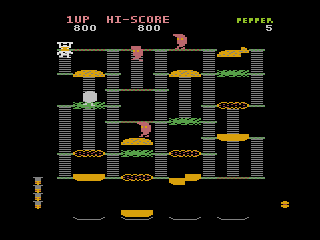 Ken
(BD): There is an Adkins and Vegetarian mode that can be activated from
codes entered on the main screen and are in the 5200 manual.
Ken
(BD): There is an Adkins and Vegetarian mode that can be activated from
codes entered on the main screen and are in the 5200 manual.
There are also is a code that enables 4 more screens, and another code that lets you play all the screen in mirror mode (flipped left/right). These are hinted to in the manual but no one has really asked anything about them. But since you have, 767 enables mirror mode and 243 enables the extra screens. These codes only work on the AA 5200 cartridge version. There may or may not be different codes that work on the demo version.
What other games are you working on now?
Bryan (CC): I'm extremely scatterbrained, and I tend to have several projects going at once. I don't like to talk about them much until I reach a point where I'm confident they will be finished. I'd rather surprise people with something out of thin air than have people lamenting my slow progress. There will be a new 5200 release soon, though.
Ken (BD): I am currently only working on Beef Drop 7800. I had some looks at the 5200 Tempest code but haven't did anything with it. Before BD 7800 I did experiment some with doing Q*Bert on the 7800 but didn't do too much with it.
Bryan, what's the story with Atari forcing AA to pull the 5200 version of Castle Crisis?
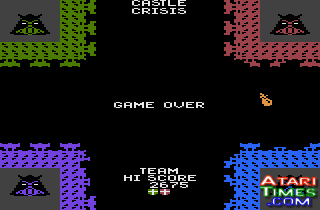 Bryan
(CC): Well, the new Atari is trying to make money off the classic stuff, so
they're enforcing their copyrights more than we're used to. AtariAge can't
afford to get into a legal battle, so I can't argue with the decision to pull
it. I don't think homebrews like Castle Crisis are the sort of thing they
need to be going after, but I'm not their high-priced lawyer.
Bryan
(CC): Well, the new Atari is trying to make money off the classic stuff, so
they're enforcing their copyrights more than we're used to. AtariAge can't
afford to get into a legal battle, so I can't argue with the decision to pull
it. I don't think homebrews like Castle Crisis are the sort of thing they
need to be going after, but I'm not their high-priced lawyer.
Ken, is there a lot involved with porting the 8-bit game to the 7800? How long do you think it will take to complete Beef Drop for the 7800?
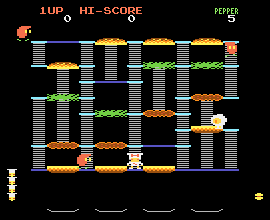 Ken
(BD): Well I originally kept the 7800 in mind when I first started writing
the game and what I had read up on on the 7800. Unfortunately I diverged a
little from that plan over time. I tried to keep the game logic pretty much
separate from the graphics logic so I could just drop in a new graphics engine.
I did not use things like hardware collision detection to make it easier to
port.
Ken
(BD): Well I originally kept the 7800 in mind when I first started writing
the game and what I had read up on on the 7800. Unfortunately I diverged a
little from that plan over time. I tried to keep the game logic pretty much
separate from the graphics logic so I could just drop in a new graphics engine.
I did not use things like hardware collision detection to make it easier to
port.
What advice would you give to someone who wants to program an 8-bit or 5200 game?
Bryan (CC): One of the cool things about classic systems is that they can be completely mastered. In a modern computer system, all kinds of things are going on that you have no control over. Of course, old systems require that you learn assembly language if you want professional results. Fortunately, modern PCs have made developing for these systems much easier. You can assemble and test your program in a emulator almost instantly, but remember to occasionally test your project on real hardware too.
Ken (BD): Start out with a small project learning Machine Language and the machine hardware and work up to a bigger project. This is much easier to do on the 8-bit computers though since you can mix BASIC and ML, and can also use other languages like Action and C as you learn the hardware.
Thanks Bryan and Ken for not only for writing this interview, but writing such faithful editions of our favorite arcade games!
| Arcade | 5200/8-bit |
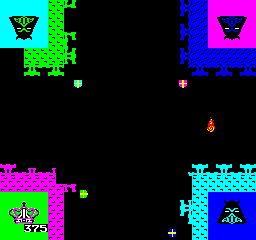 |
 |
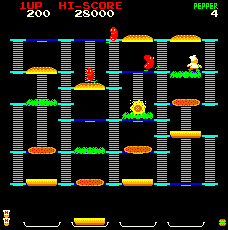 |
 |
| 7800 version of Beef Drop | |
 |
|
| Name: | |
| Subject: | |
| Comment: | |
| Check: | What is the greatest video game company of all time? (Hint: Atari.) |